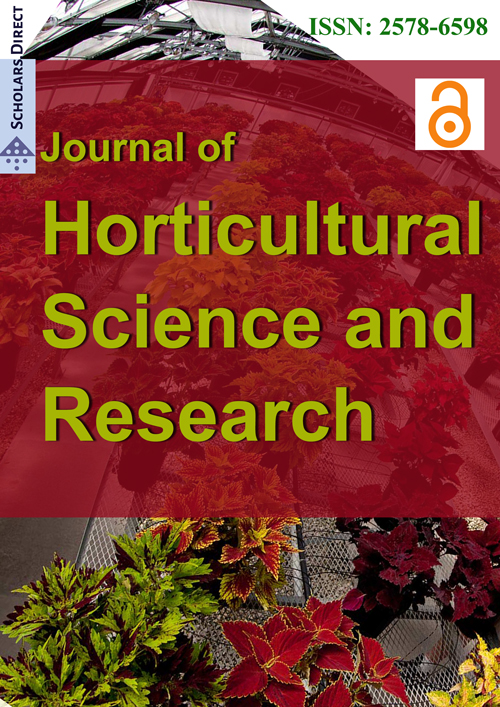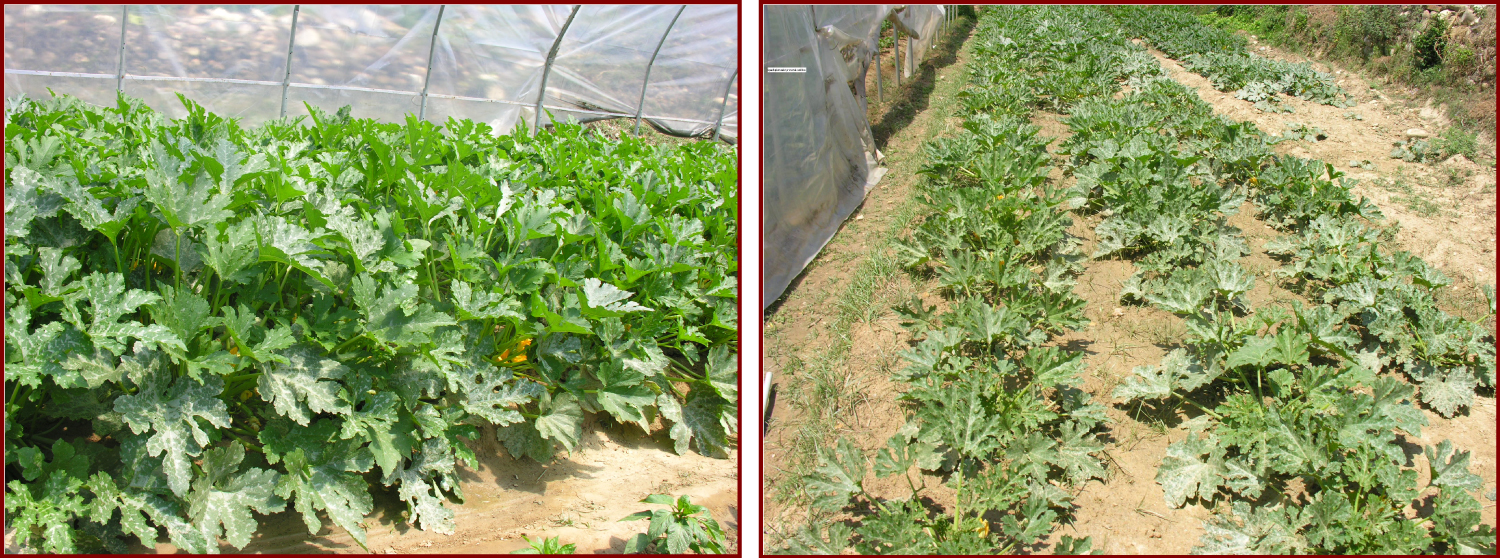Protected Cultivation of Summer Squash in Mid-hills of Uttarakhand
Abstract
Mid-hills of Uttarakhand constitute major part of agricultural land in north-west Himalaya. This region has unique advantage of off-seasonality in vegetables production. Sub-optimal temperature during winter months is the major limitation in vegetable production in the region. Polyhouse provides a protective cover during winter and spring for successful production of off-season vegetables like summer squash for early market.
Introduction
In North West Himalayas, major problems are small and marginal land holdings, lack of alternate livelihood and poverty. Cultivation of marginal lands with growing condition such as extreme low winter temperature, steep slopes and soil erosion adversely affect the crop productivity and profitability. These further aggravate the problems of hill agriculture. However, on the other hand the North Western Himalayan region offers niche advantage of off-seasonality with respect to plains, in vegetable cultivation.
Therefore, it is imperative to develop production technology of off-season vegetables to satisfy the growing needs of food, nutrition and economic security of the region. Importance of vegetables is progressively increasing because of high profitability, growing market and awareness of nutritional security. Cultivation of off-season vegetables under polyhouse provides an opportunity to hill farmers to produce vegetables with high quality and yield, assured regular supply and off-season availability. The polyhouse provides a protective structure, which develop congenial environment for the plant growth and development. It modifies the inside environment in such a way by raising temperature through greenhouse effect that the crops can also be grown during winter period, whereas it is not possible to be grown under open field condition. Advantages of the greenhouse are well defined (Figure 1).
Major advantages are as follows:
1. Earliness: Temperature moderation facilitated early transplanting of seedlings and fast growth and development inside greenhouse provide early harvest of the crop. The early arrival of produce in the market fetches a high price as compared to the generally late harvest from open field crops. It was possible to have early harvest of summer squash in polyhouse by 14 days than open field (Table 1).
2. Protection from natural vagaries: Polyhouse provide protective cover to the crop from natural calamities such as heavy rainfall, snowfall and hailstorm, which is of common occurrence in hilly regions. During study period, open field squash crop damaged due to heavy rainfall as well as hail storm.
3. Productivity: The plant inside the polyhouse gets favourable condition for plant growth and development; therefore, the yields are also higher (Table 1). The total number of fruits and average fruits weight are higher under polyhouse as compared to open field crop. The yield inside the polyhouse is 1.5 to 2.0 times more as compared to open field.
4. Protection from disease and pest: The polyhouse gives a protective cover to the crop from insects and pathogens. Polythene sheets do not allow these organisms to enter inside the polyhouse. Whereas, the insect and pathogens present inside the polyhouse can be easily controlled. The controlled environment makes it convenient to implement all control measures including IPM inside greenhouse.
5. Economics: The initial cost of construction of a well-equipped polyhouse is high, that a poor or marginal farmer cannot bear. But, the low-cost naturally ventilated polyhouse structures constructed by using local materials as bamboo are becoming popular among the farmers. The higher yield and good market price of polyhouse produce make it very remunerative. Thus, it strengthens the economy of farmers. The data in Table 1 also supported the above statement.
6. Employment: Polyhouse cultivation is labour intensive which helps in generation of rural employment. One person is permanently required to look after all operation of crop cultivation and maintenance of polyhouse. Shortage of labour even for one day during peak demanding period may lead to economical loss.
Summer Squash Cultivation
Summer squash (Cucurbita pepo L.) is a quick growing summer vegetable crop, which belong to family cucurbitaceae. It has originated in tropical America. Summer squash or marrow is an annual bush and becoming popular in hills. It is the earliest summer vegetable to appear in the market. It is generally consumed as cooked vegetable in the immature stage. In the mature stage, its seed and shell become hard and unfit for consumption. It is a rich source of vitamin C and minerals. Vegetable marrow is considerably tolerant to frost as well as to heat, and can be sown fairly early in spring season. The seed is generally sown in February and March in hills but for early market, the seed is sown in polybags during January to first week of February in polyhouse. About 8 to 10 kg of seed is required for one hectare.
Soil and its preparation
With good management practices, summer squash can be successfully grown on most soils of the hilly regions. Well drained, sandy loams with high levels of organic carbon and a pH of 6.0 to 6.5 are considered suitable for its cultivation. A good crop of summer squash requires abundance of nutrients supplies. Therefore a fertile soil is required for its cultivation. Land should be thoroughly ploughed and the residue of previous crop should be removed. Rotten farm yard manure at 20 to 25 tonnes per hectare, should be applied before preparing the seed bed. An additional application of 100:50:50 kg of NPK should be made. 50 per cent of N and full dose of P and K should apply as basal and rest half of the N top dressed at flowering stage. Timely application of fertilizer makes a significant difference in the quality and yield and it may promote to early harvest.
Varieties
The variety grown in hills is of bushy habit. The most popularly grown variety in the hill is Australian green. Early Yellow Prolific and Pusa Alankar are also grown in the regions. Australian Green is a very early and bush type variety. Fruits are very tender, delicious and good yielder. It is sown by two methods: Either by direct seeding or by raising nursery. For early crop, seedlings are raised in polybags inside polyhouse. At two true leaves stage, seedlings are transplanted in field. In direct seeding, seeds are sown in raised bed at proper distance (90 × 60 cm).
Irrigation and interculture operations
Proper watering is necessary for good growth and yield. Summer squash is high water requiring crop. The crop should be irrigated every 3rd or 4th day. The most critical stage for irrigation of summer squash is fruit development. Water stress at fruit sizing will result in pointed and misshapen fruit which are unmarketable. The weeding and intercultural operations should be carried out as per need, either twice or thrice.
Harvesting and yield
Summer squash are harvested when they appear shiny, young, tender, and are of marketable size (as immature fruit). The fruits should be cut with knife, rather pulling or twisting it. It is harvested either in early morning or evening. The polyhouse produce is ready to harvest early as compared to open field. The first harvest of squash is of best quality. The quality of fruits harvest decrease with increase in planting age. Fruits are ready for harvest in every 4-5 days. The average yield of green fruit in polyhouse is 600-800 q/ha, whereas under open field is 300 to 400 q/ha.
Common Diseases of Summer Squash
Powdery mildew
It is severe in warm rain free days. The disease is primarily caused by Erysiphe cichoracearum. This disease can reduce yield significantly by reducing the number and size of fruits as well as the length of time a crop can be harvested. It is a common problem in summer squash in hills. It first appears as pale yellow spot on stems, petioles and leaves. These spots expand and merge and become covered with a superficial powdery, white to gray fungal growth. This white spot may also appear on lower leaf surface. The principal control measure for powdery mildew is timely application of calixin (0.05%) or karathane (0.5%) is recommended for its control.
Downy mildew
It is caused by the fungus Pseudoperenospora cubensis. It is prevalent in area of high humidity especially when summer rains occur regularly. The disease can be confused with symptoms of powdery mildew. However, the two diseases are favoured by different weather conditions. It is characterized by formation of yellow or more or less angular spot on upper surface of leaves while purplish spot appear on lower surface of leaves. Practices that reduce leaves wetness and lower relative humidity within the plant canopy will reduce fungus development. Good soil drainage, increase in row spacing for aeration and avoidance of over head irrigation are some of the practices to reduce its incidence. Spraying of Dithane M-45, maneb, mancozeb is effective in controlling downy mildew.
Rhizoctonia root rot
The fungus is pathogenic to all cucurbits, causing both pre- and post-emergence mortality. Older plants are less susceptible to the disease. Control of disease can be obtained with application of vitavex or brassicol.
Viral disease
There are many viruses that attack squash in hilly regions. The symptoms first appear on youngest and expanding leaves. A mosaic pattern may develop on leaves (healthy dark green leaf tissue intermingled with light green and yellow tissue). Leaves are often distorted, crinkled, curled and stunted. Vines may look like bush due to shortening of internodes.
The control of mosaic viruses in squash begins with eradication of biennial and perennial weeds and wild reservoir hosts in and around polyhouses. Application of insecticide is followed to control of vectors like aphids and whitefly. Roguging of infected plants is necessary to check its spread.
Insects-Pest of Summer Squash
Red pumpkin beetle
Spotted and striped beetles attack mainly at young seedling stage as soon after emergence, to feed on cotyledonous leaves and stems. The critical period for beetle control is within the first 2 to 3 weeks after plant emergence. Application of recommended insecticides as carbaryl (sevin) 0.1 to 0.2% or rogor (0.1%) can control the beetle inside polyhouse.
Aphid
Aphids are small, soft bodied insects, usually green or red, with piercing and sucking mouthparts. Aphids are mainly found in colonies growing on new growth or on the lower side of the leaves. Infected leaves may be distorted and become cupped in appearance. The main damage to the crops, however, results from many plant viruses that it transmits. Mainly insecticides (malathion etc.) are recommended for its control.
Fruit Fly
This is a very serious pest of most of the cucurbits. The adults, which are a bit smaller than housefly, puncture the skin of the ovary or the young fruit and lay eggs. The maggot after hatching starts feeding inside the fruits. The infected fruits get deformed and often rot with secondary infection. Its control is very difficult. The infected fruits should be picked and destroyed. Malathion or Thiodon or Endosulphan is recommended in the very young start of the fruit.
Summary
In mid-hills, cultivation of vegetables starts with rise in temperature in March onward. The sub-optimum temperature during winter months can be moderated for crop production under polyhouses. Polyhouse cultivation can make early plantation of vegetables possible, during months of January and February. Fast growth and development of crops under protected condition provide early harvest during off-season due to which produce are getting higher price in the market. The study also showed the advancement of 15 days in flowering and 20 days in first harvest under polyhouse in comparison to open field. The yield of squash inside polyhouse was doubled in comparison to open field. Similar trend was recorded in case with gross as well as net return, which shows the advantages of polyhouse in the region.
Corresponding Author
Suneeta Singh, Assistant Professor, Department of Horticulture, School of Agricultural Sciences, SGRR University, Dehradun- 248 001, Uttarakhand, India
Copyright
© 2020 Singh S, et al. This is an open-access article distributed under the terms of the Creative Commons Attribution License, which permits unrestricted use, distribution, and reproduction in any medium, provided the original author and source are credited.





